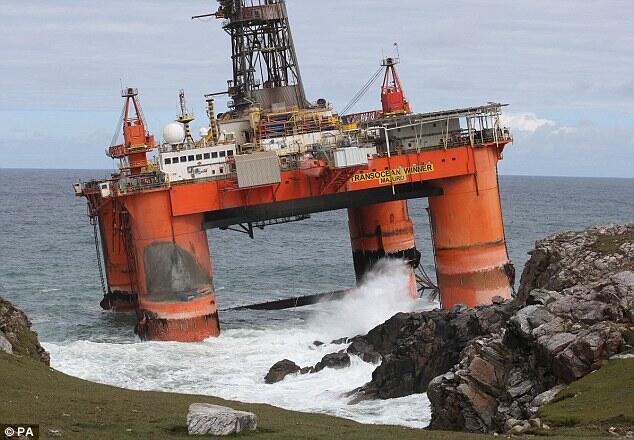The UK coastguard agency has been accused of a pollution “cover-up” over the oil rig that ran aground in northwest Scotland last month.
An internal report from the Scottish Government’s environment watchdog published by The Ferret reveals that there was diesel contamination around the rig at Dalmore beach on the west coast of Lewis.
This was despite repeated statements by the Maritime and Coast Agency (MCA) at the time that there was “no pollution” from the defunct Transocean Winner rig after it stranded on 8 August.
Environmentalists have attacked the MCA for misleading people and breaching public trust, and are demanding explanations. But the MCA stresses that its aim is to be “totally transparent”.
The pollution was detected in the days after the oil rig came ashore by scientists from the Scottish Environment Protection Agency (Sepa). Their report was released last week in response to a request under freedom of information law.
“On-site operations identified potential hydrocarbon contamination on the shoreline,” the report said. “Responding organisations also reported an odour in the air and members of the Coastguard reported experiencing sore throats.”
The scientists reported “low levels of weathered diesel” in two seawater samples, and elevated levels of two toxic chemicals from diesel, benzene and toluene, in the air. Concentrations of the chemicals in the air on 11-13 August ranged from 0.22 to 1.32 parts per million.
“The values observed are higher than the expected background concentrations for this area,” the report said. But they were “below all compared health related exposure limits”.
The results of Sepa’s monitoring were shared with the MCA, but neither organisation publicised them. Instead the MCA issued a series of statements saying that there was no sign of pollution from the rig.
“There has been no pollution detected in the area of the rig…No sheen or sign of pollution has been found,” the MCA said on 11 August. On 15 August it added: “There are no reports of pollution”
Dr Richard Dixon, the director of Friends of the Earth Scotland, thought it was fortunate that there had been no massive pollution incident. “But the MCA clearly denied there was any pollution at all when they knew that both air and water samples were polluted by diesel fuel,” he said.
“The MCA will have to explain why they covered up the pollution and misled the public. This cover up will also no doubt strengthen the case being made by locals for compensation.”
Mark Ruskell MSP, environment spokesperson for the Scottish Greens, argued that agencies should have figured out how to work together to monitor incidents and release information. “With a serious incident such as this, the public have a right to know every detail, but by withholding information the MCA are damaging public trust,” he said.
Calum Duncan, head of the Marine Conservation Society in Scotland, pointed out that though levels were low there had been air and water pollution. “Whilst we are glad there does not appear to have been gross pollution or human harm from the grounding, any is unacceptable,” he said.
“For public confidence, all known information needs to be available as soon as possible after any incident. All agencies involved therefore have to learn from this to be clearer and more joined-up with their public updates.”
In a telephone interview, the UK Secretary of State’s representative for maritime and salvage, Hugh Shaw, pointed out that he had clearly said that up to 53 tonnes of diesel missing from the oil rig could have dispersed or evaporated.
“There was no reason for us to cover-up that there had been these small losses,” he said. “We just report as it is, and put all the facts out there.”
In a statement the MCA stressed that it took its responsibilities very seriously. “While we were aware of reports of a light sheen and smell of oil, our investigations showed no evidence of pollution in the area,” it said.
“From the start the MCA and all those involved in the salvage operation have worked hard to minimise the impact of the grounding of the Transocean Winner and to make sure that any potential pollution is found and dealt with.”
The rig was floated from Dalmore beach on 23 August and towed around Lewis to Broad Bay, where it is being prepared to be transported to Turkey for demolition. On 30 August MCA announced that divers had found 40 pieces of debris from the rig off Dalmore beach.
After media inquiries about the pollution, the Scottish Government released a 90-page draft report on the incident from Marine Scotland on 2 September. It included the Sepa pollution report, as well as monitoring of seabirds and local fish farms that had found no effects.
According to Sepa, the pollution it had detected was not “significant” and it was not clear how much could be blamed on the rig. “Sepa worked closely with all relevant partner organisations in relation to the Transocean Winner incident, and shared the results of our investigations with partners as soon as these results were confirmed,” said a Sepa spokesman.
Source: The Ferret











